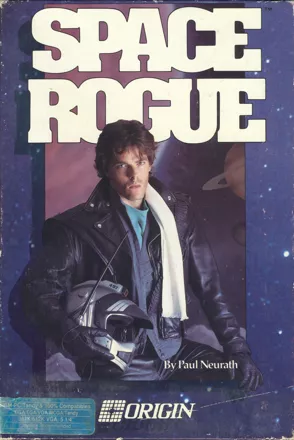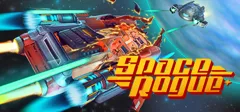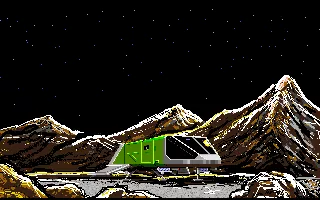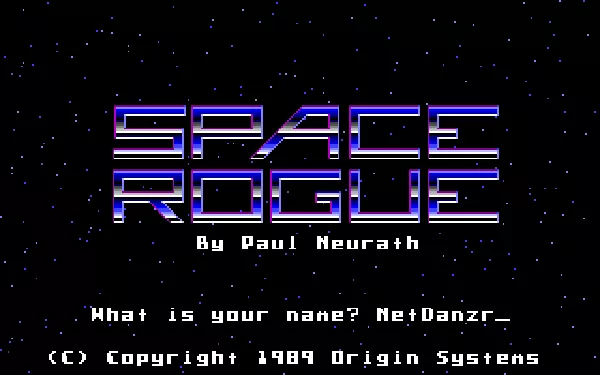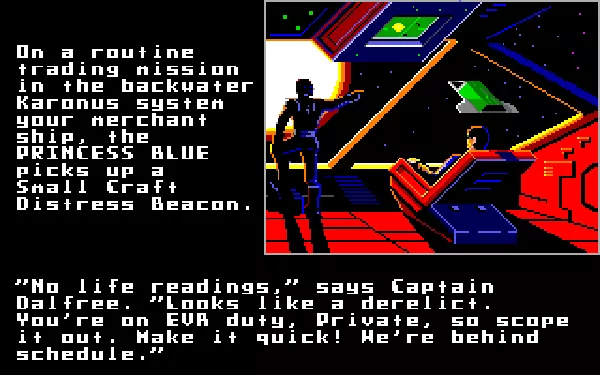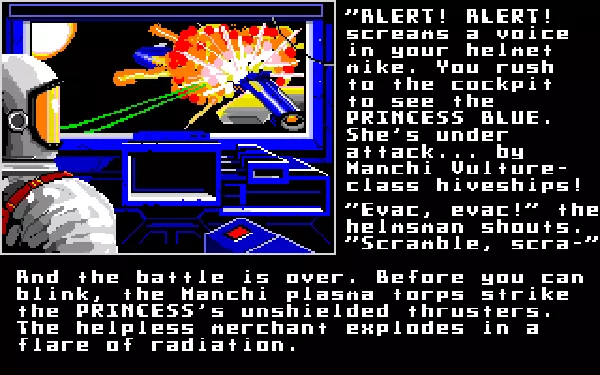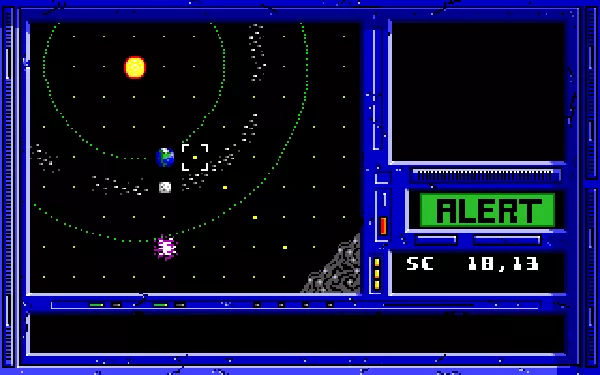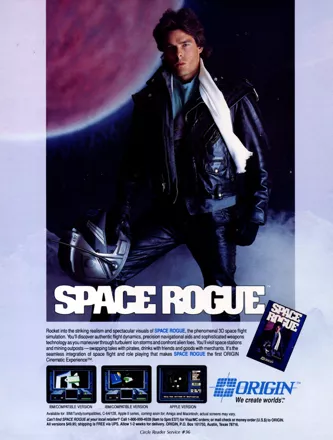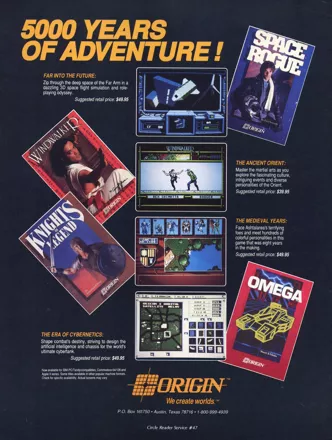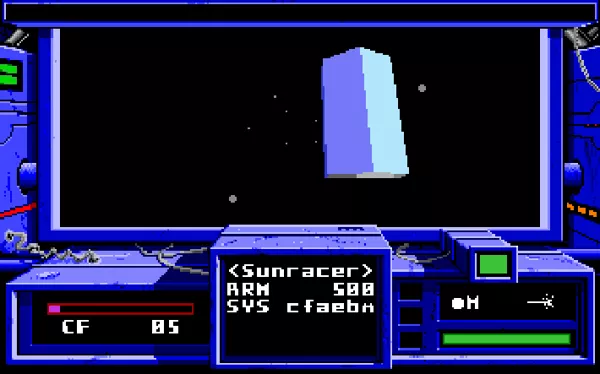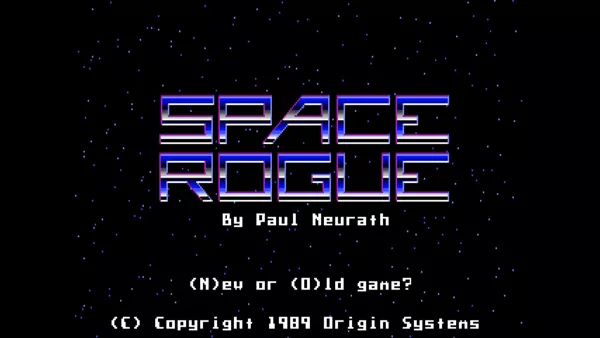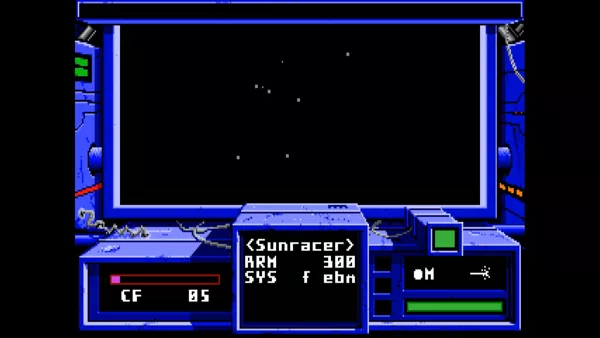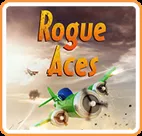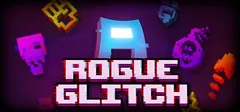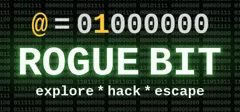Space Rogue
Description official descriptions
The Princess Blue was a trading vessel. While cruising through space, it happened upon a derelict ship floating in space. Only one crew member was allowed to investigate the abandoned ship. Suddenly, Manchi raiders appeared on the viewscreen. The Manchi managed to ambush and destroy the Princess Blue. The only surviving crew member from the Princess Blue swears revenge and is determined to do everything in his power to defeat the Manchi.
Space Rogue is a hybrid game that combines space flight and combat simulation with trading and RPG elements such as interaction with characters and a quest-based structure with a main plot line. Space flight takes place in two different modes: Cruise Flight, which is ideal for travelling quickly, and Newtonian Flight, which works best for combat and precision flying. There are also three different camera views for the 3D exploration and combat. Each planetary system has a variety of destinations and obstacles to travel through via a top-down navigational map. Traveling to an outpost, a space station, or any other location with the star system can be done simply by selecting it and charting a course, or in real-time 3D flight mode.
Interstellar travel between systems, is done by finding a Malir Gate and using it to reach hyperspace. While in hyperspace, the game becomes a simple 'tunnel' game where the player must manually control the ship not to hit any of the walls. Also hyperspace travel eats away at the ship, so the faster the player can get through them, the more armor the ship retains. While traveling in space the ship may get attacked, or the player may opt to assault any other ships first.
It is also possible to buy and sell various goods, earning money and spending it on outfitting the ship with weapons and various upgrades, such as for example a device that allows it to move more stealthily through space and avoid detection by hostiles. The player character has a reputation rating with various factions such as the Imperium, the pirates, and others. This rating is affected by the player's actions towards them and can be raised or lowered by helping specific factions fight others.
When docked at outposts or stations, the view shifts to top-down, and the player navigates the protagonist through the location in an adventure or RPG-like fashion, examining objects and talking to characters. Conversations may have multiple choices, and a few instances require the player to type in keywords, though for the most parts responses are selected from a menu. The game has a main plot line that requires finding, talking, and performing tasks for characters, as well as sub-quests that may result in various rewards such as money or ship upgrades.
Spellings
- スペースローグ - Japanese spelling
Groups +
Screenshots
Promos
Videos
Add Trailer or Gameplay Video +1 point
See any errors or missing info for this game?
You can submit a correction, contribute trivia, add to a game group, add a related site or alternate title.
Credits (DOS version)
28 People · View all
| Design | |
| Programming | |
| IBM Adaption | |
| Producer | |
| Associate Producer | |
| Graphic Design | |
| Additional Material | |
| Product Packaging | |
| Photography |
|
| Playbook | |
| Playbook Art |
|
| Playtesting |
|
| [ full credits ] | |
Reviews
Critics
Average score: 72% (based on 20 ratings)
Players
Average score: 3.8 out of 5 (based on 36 ratings with 3 reviews)
Awesome open-ended space-shooter!
The Good
This game is everything that Freelancer ought to be. It's open ended, there are tons of ways to make a living, and everything you do affects how the various factions treat you.
I wish I owned it right now, instead of borrowing it, way back when.
The Bad
I remember traveling through the worm-holes was a pain in the butt. Otherwise, no issues.
The Bottom Line
A great game with a lot of replayability.
DOS · by ex_navynuke! (42) · 2005
The Good
This was Paul Neurath's first game for Origin. He would later go on to found what would become Looking Glass Studios which produced the likes of System Shock and the Ultima Underworld games. This is a much less grand game than either of those but still impressive in its own way. It's very much influenced by Elite and Origin's earlier RPG's and plays like a primitive version of Privateer with a bit of 2400AD thrown in.
The plot at the start of the game is quite open ended. You are part of the crew in a merchant vessel that comes across a scout ship floating in space. You are sent out to salvage the ship but just after you reach it your base ship and all the crew are destroyed by an attack force of Manchi aliens. They leave the scout ship alone, however, so you take the ship under the laws of salvage and set out to find out why they would attack a merchant ship. The story is expanded upon by the characters you meet and without giving anything away you eventually discover the cause of the attack and save the day.
The game is divided into 2 distinct styles of game-play. First off is the 3D spaceflight. The 3D graphics for this are extremely basic. A space station for example is simply two pyramids with a square block sandwiched inbetween. Playing this, you can see why people were blown away by Wing Commander which came out just the next year. This game did run smoothly on an 8088 PC however and is in full 3D. Once you get used to the graphics they do the job.
Flying the spaceship around is a little more complex than you might expect. There are two types of flight mode (cruise flight and Newtonian). Cruise flight is your typical flight sim style control where the ship attempts to correct your trajectory when you turn. At speed this mode is still tricky as the ship has a tendency to keep going in the same direction after you have turned. Newtonian flight removes the course correction and you can point in one direction and move in another at will. In theory this could be useful in combat but I stuck with cruise flight for the entire game without any difficulties.
While playing the game you run into various type of other spacecraft. Depending on how you want to play the game these can be largely ignored or you can raid them for cargo or bounty depending if you attack merchants or pirates. You really need a well equipped ship for either of these careers though and once your ship is well equipped you don't need the money so much. The easiest way to make money by far is trading goods. Once you have established a good trade route you can make 1000+ credits every trip. This compares to 65 credits a kill bounty hunting, or a single piece of cargo if pirating. I'd like to have seen this balanced out a bit more.
Your popularity in the game is tracked against the three factions of police, pirates and merchants. If you go around attacking ships these can change depending on who you attack. You can even raise your merchant rating by saving a merchant from a pirate attack. If you get disliked in one of these factions then ships may attack you on sight again making anything except the merchant route a tough way to play the game. If you play the game as a merchant then attacks by pirates are rare and easy to cope with even with the most basic of equipment.
Combat isn't really all that tactical. Its pretty much a case of point your ship at the enemy and keep firing until it blows up. The laser has varying levels of charge and will do more damage if you only use it at full power. Its possible to use more advanced tactics if you wish though. If you want to take on some of the bigger ships, then you can potentially sneak up to point blank range and dumb-fire a missile at them. You can use Newtonian flight to pivot your ship and shoot down the pursuing alien. Alternatively, if you want to escape combat you can fly toward a planet or star and its gravity will actually speed you up. This level of detail in a game this old is really impressive.
There are about 12 sectors of space in the game, each of which is a 32x32 grid. Your ships navigation systems can be used to move between each tile on the grid. There are different types of space. i.e. asteroids and nebulae all of which affect flight as you have to avoid collisions when manually flying. To get between sectors there are malir gates. These are giant tubes which connect 2 sectors. Flying into one puts you into a worm hole (basically a bendy tunnel) which you have to navigate through the middle of to arrive at the other sector.
Each sector has one or two places you can land. There are 4 types of thing to land on (star bases, trading stations, mining stations on asteroids + a military carrier ship). Once you land, the game transforms into one of Origin's tile based RPG's.
Every space station is different but quite small so they don't take a lot of exploring. There are numerous ship upgrades available in some stations, repairs, cargo merchants and bars. The bars often have random people in them who may give you information or missions. There are also some characters who stay put and live on the respective station, near enough all of which will be involved in one mission or another before the end of the game. Conversation is carried out largely through multiple choice options but also uses typed keywords. The cast of characters is quite small, but well developed and the quality of writing is above average.
The Bad
The two aspects of the game don't really seem to be linked together. A mission will consist of flying somewhere and doing/getting something but none of this affects the space-flight part of the game. You are never ambushed as part of a mission and ship encounters appear to be entirely random throughout the whole game. This makes things feel a little bit disconnected. Once you get further into the game, the flying through space can start to feel a bit like filling in time.
If you die the game dumps you back into DOS. At this point you have to start the game up again, skip the intro, load your game and find the word in the manual to get past the copy protection. On an 8088 PC this isn't a quick process. There is one section in the game where you have to avoid a monster on one of the stations and so much as touching this monster kills you. Restarting 10 times in a row here can get annoying.
The Bottom Line
Overall, the game feels a bit underdeveloped. The storyline is fairly brief, there aren't that many systems to explore or places to land, the number of upgrades you can make to your ship is quite limited and you can afford them in no time once you establish a trade route. Elite had been there long before this and did a better job of presenting an entire universe to explore. Elite didn't have the storyline and RPG elements of Space Rogue, however, and I like to have a goal to aim toward in a game.
I'm probably expecting too much from a 1989 game. Privateer would take this genre to a whole new level but that was still years away. Space Rogue is always entertaining, easy to get absorbed into and presents a credible 3D universe on very basic hardware.
DOS · by Pix (1172) · 2008
The Good
This was way ahead of its time; A polygonal space flight sim in the vein of Privateer, with mulitple systems to explore, multiple ways to make a living, and a reputation system where everybody treats you differently. Geez... where to begin.
Okay, the scope. This was a pretty cool blend of action and adventure. With a little imagination each visit to a space station would be a memorable encounter. There was the usual barter and trade stuff, but then again there were things quite unexpected. Civilians would approach you with offers to transport goods, or even want you to taxi them elsewhere! Sometimes the cops or the criminals would employ your help, and the favors they'd return would sometimes go beyond cash... maybe a special cargo pod to conceal that contraband?
How to make a living... this you should recognize the most from Privateer. Merchant? Bounty Hunter? Alien Hunter? PIRATE!? This is where things started to get seriously intense, because it led straight into the...
RATING SYSTEM: Not a cheap "One rating, everybody reacts to that" deal. You had ratings with EVERY FACTION AROUND. Save a merchant ship, score points with them. Save a merchant ship by destroying an attacking pirate, lose points with the bad guys... and if you ever need a favor from them, be prepared to pay through the nose... Help the cops by being a bounty hunter and they'll start to chum around with you. Hurt them and they'll start extorting your bounty out of you. It goes on and on.
Gameplay was no slouch, either. All of the planets and stars were actually in there with you, no cutouts you could never reach but actual gameplay elements of gravity and velocity. Even binary stars, two stars orbiting each other! My fondest gameplay memory involved a binary star system where I was getting trashed by an alien, totally wrecked at the worst time. I couldn't outrun it and I was far, far away from any help. I turned the nose of the ship to face between the two stars and hit full burn. As the gravity started sucking I started flying in faster than the ship could possibly go under its own power. I started to get pulled off course, towards one of the stars, and then... I shot between them and out to the other side, leaving the alien way back in nowheresville.
This is the kind of moment that makes me love a game.
The Bad
Okay, the sound and occasional music can't even be remembered at this point. They must not have been anything special. Also, there was one sequence when I had to make a landing on a station that had been ravaged by a mutant, get in to steal an item, and get back to the ship without getting slaughtered. The mutant was way too fast. I saw him enter the screen, then I died. And don't assume it was a system thing, I was running a P.O.S. Tandy 1000 S(U)X that was WAY underqualified to even be plugged in. No, that was something that made me turn over the keyboard to my buddy while I went and swallowed nerve relaxants by the bucket.
The Bottom Line
Possibly the FIRST space adventure with this kind of scope, Space Rogue was around and kicking butt long before Wing Commander conquered our monitors.
DOS · by Vance (94) · 2000
Trivia
Like all of Origin's titles released in the 80's, this one came with a weird knickknack: a series of carboard cutouts that you could fold and turn into a 3D spaceship!
Analytics
Identifiers +
Contribute
Are you familiar with this game? Help document and preserve this entry in video game history! If your contribution is approved, you will earn points and be credited as a contributor.
Contributors to this Entry
Game added by Old man gamer.
Apple II added by John Romero. Linux, Windows added by Cavalary. Atari ST added by Dietmar Uschkoreit. Amiga, PC-98, Sharp X68000, Commodore 64, FM Towns, Macintosh added by Terok Nor.
Additional contributors: Trixter, Terok Nor, Shoddyan, Cavalary.
Game added June 15, 2000. Last modified August 2, 2024.


